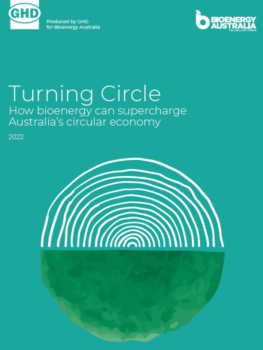Turning Circle: How bioenergy can supercharge Australia’s circular economy
Full report available here
Turning Circle: How bioenergy can supercharge Australia’s circular economy
This work was produced by GHD for Bioenergy Australia. It was co-funded by IEA Bioenergy through its Task 36 – Material and Energy valorisation of waste in a Circular Economy
The report highlights that by shifting from a linear waste management model to a circular economy, Australia can move from being one of the highest per capita waste generators in the world to a recycling and remanufacturing powerhouse.
- We are overdrawing on our world’s natural resources and polluting our environment. For a sustainable future, we must move from a linear ‘take-make-use-dispose’ society to one where resources are kept in circulation for as long as possible and pollution and waste are avoided. Bioenergy and bioproducts – renewable energy and material generated from organic materials– are an essential component of a circular economy and can accelerate Australia to a carbon neutral 2050.
- Australia has abundant materials suitable for the generation of bioenergy. The Australian Bioenergy Roadmap reports Australia could generate up to 559 PJ per annum from bioenergy in total. Modelling for ARENA’s bioenergy roadmap calculates bioenergy could provide up to 20% of Australia’s total energy consumption by the 2050s. But we haven’t even begun to realise bioenergy’s potential here.
- Bioenergy offers the opportunity to tackle the otherwise hard-to-abate areas including renewable gas grid injection, renewable industrial heat generation and aviation. It provides direct substitutes for fossil-fuel derived products, and avoids fossil fuel derived greenhouse gas emissions. Bioenergy generated from biomass, including agricultural and forestry residues, commercial and household food and garden organics, circulates the energy and carbon embodied in those materials. Burning fossil fuels releases carbon that has been locked up in the ground for millions of years, while burning biomass or biomass-derived fuels emits carbon that is part of the biogenic carbon cycle.
- Overseas experience shows that consistent, sustainable policy support with industry partnerships is integral to establishing and growing a bioenergy industry. Policy by itself, however, is insufficient. Industry should build its capabilities, develop innovative projects and business models and clearly articulate where bioenergy has a comparative advantage against other low emissions alternatives. These integrated efforts have proven to be successful in other jurisdictions and are expected to foster equivalent benefits in Australia.




